Driving from Florence to Rome: what to see on a road trip
If you are planning to visit both Florence and Rome, a good idea is to rent a car, take a road trip and stop to visit other beautiful small towns and villages. Tuscany and Lazio are regions full of gorgeous places to visit, charming ancient villages and beautiful Italian countryside landscapes. So I put together my tips on what to see between Florence and Rome on a road trip. They are places I know well and have visited often… I hope you’ll find it useful for planning your travel!
In case you don’t want to drive, here you can find all the information you’ll need to get from Rome to Florence by train (and vice versa).
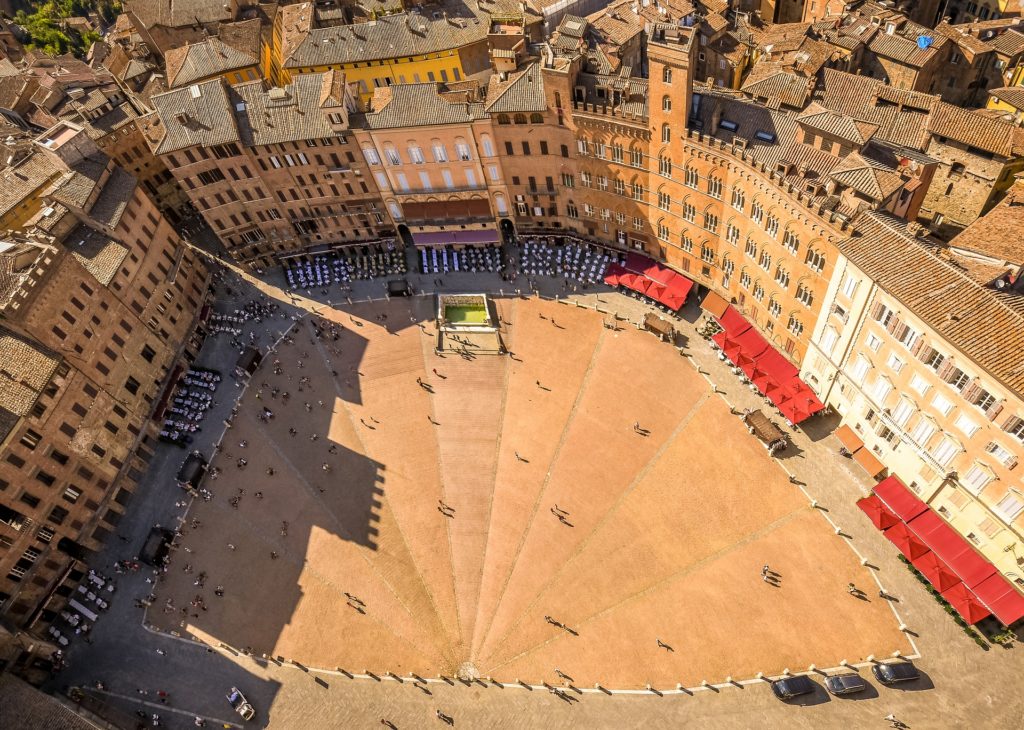
What to see driving from Florence to Rome
I have listed the places to visit along the route in order from Florence to Rome, of course these tips also apply if you want to take the opposite route. The road will cross three different regions of central Italy: Tuscany, Umbria and Lazio.
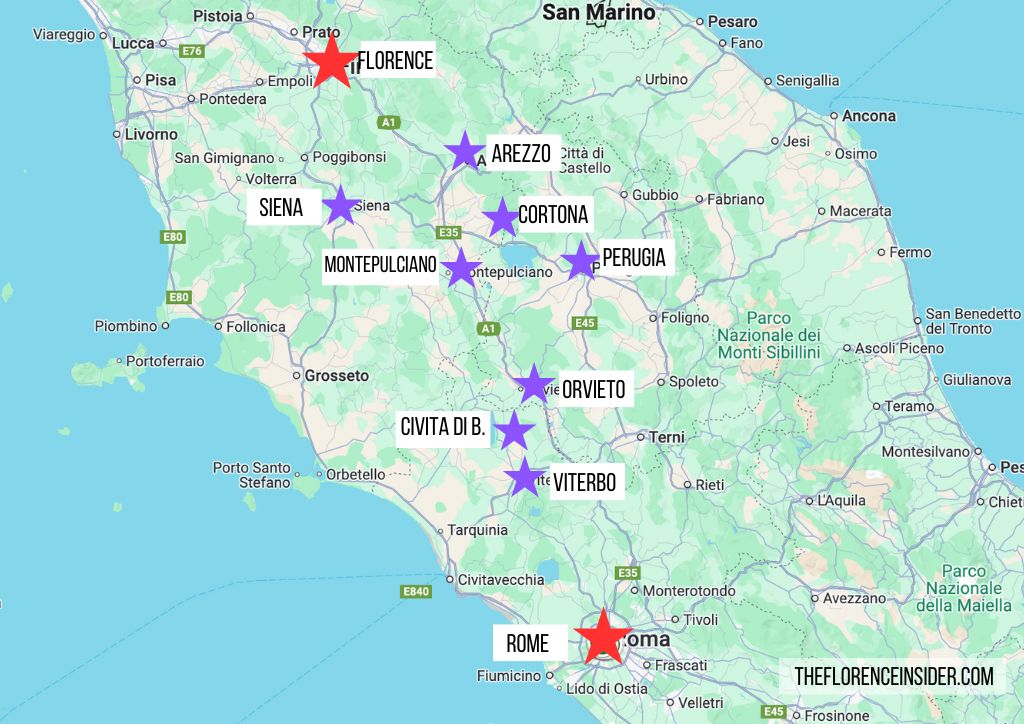
Since you’ll be starting from Florence (or you’ll end your road trip there), some tips about parking in Florence might be helpful.
Arezzo
A lovely medieval town in the heart of Tuscany, Arezzo is famous for Piero della Francesca’s Renaissance frescoes in the Cathedral and in the San Domenico church. Every first Sunday of the month the antiquities market drives hundreds of people here, from all over Italy (but you’ll find also little wonderful antiquities shop). Don’t miss its beautiful Piazza Grande, with stone buildings covered with coats of arms, and the panoramic view from Medici Fortress.
Arezzo is definitely one of my favorite destinations for a day trip from Florence by train, because it’s very close to Florence (you can get there with less then one hour by train), and can be easily visited in one day.
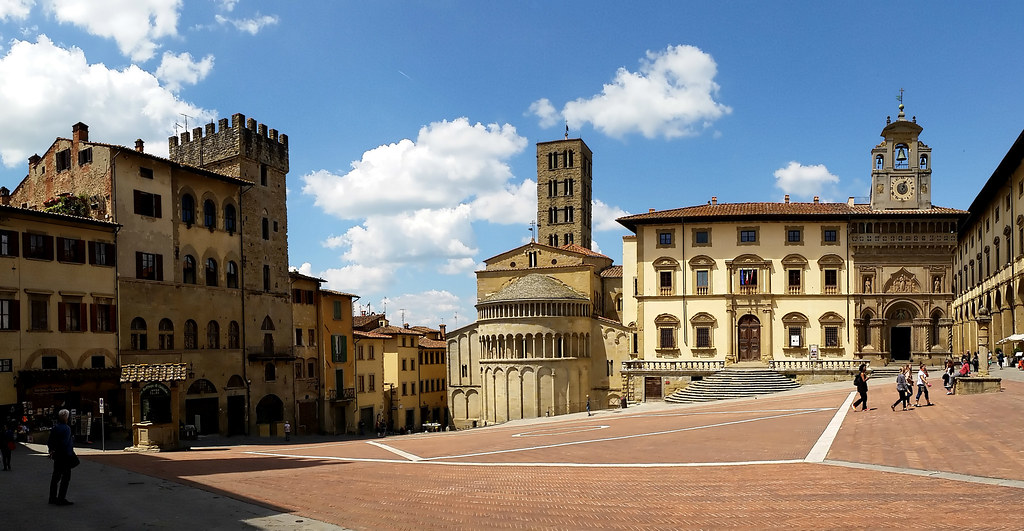
Siena
Siena is one of the most beautiful and rich in history cities of Tuscany, almost unmissable. I love the ancient Piazza del Campo, with its Gothic town hall and the Torre del Mangia. Not to mention the wonderful cathedral, built to rival with the one of Florence, and the historic center made up of characteristic alleys. Art lovers will find museums and churches full of medieval and Renaissance art, while foodies can enjoy the excellent local cuisine.
In the summer, the most important historical event is held, the Palio of Siena, a horse race through the medieval streets of the city, where the 17 districts of Siena, called Contrade, compete. It is an ancient tradition, probably started around 1200, which today has become much debated. For the people of Siena it is a precious and unmissable tradition, for many other Italians it is a barbaric race where many horses get injured by slipping on the stone-covered streets, and then they must be put down to sleep. The Palio of Siena is traditionally held on July 2 and August 16 of each year, but it can be postponed due to the weather. During those two days, but also on the days before and after, Siena is literally monopolized by the Palio, and it becomes hard to visit the city in peace. If you want to attend this historic race be prepared to book tours, entrance tickets and accommodation well in advance, and expect much higher prices than usual. Otherwise, I recommend avoiding Siena on the days of the Palio.
Siena is a small city and is totally walkable, but is so packed with things to see and do, that you can easily spend two ore three days there. In case you need a place to stay, last time I was in Siena I stayed in this hotel and I loved it!
Cortona
Nestled in the Val di Chiana valley, Cortona is a very characteristic medieval village, made famous by the novel Under the Tuscan Sun. Here you can visit the Etruscan museum, ancient monasteries in the countryside and take walks in the historic center. The Etruscan museum is really interesting, if you want to know more about the Etruscan Civilization also check the Etruscan museum in Viterbo (it’s one of the next stops that you’ll find below).
One of my favorite places in Cortona is the hermitage Le Celle, a monastery clinging to a rock wall, isolated in nature and surrounded by woods, streams and green hills. Here in 1200 Saint Francis built some small cells for the friars, and even today, 8 centuries later, the friars live here leading a life of prayer and isolation from the world. You can get there by driving for a couple of km on the SP34 road, which starts from the center of Cortona.
Cortona is also famous for its great food and extra virgin olive oil, one of the best ones in Italy. In November there is also an important olive oil festival.
Montepulciano
Known for its noble wine (Vino Nobile di Montepulciano), this medieval village nestled on the top of a hill is surrounded by vineyards. You can enjoy the view of the village and the Tuscan countryside from the top of the Palazzo Comunale tower.
This is the perfect stop for wine lovers on a road trip between Florence and Rome, as Montepulciano wine is definitely one of the best ones not just in Tuscany, but in the whole Italy. But also if you’re not a wine lover, you will probably love the experience of a wine tasting tour in Montepulciano, inside one of many centuries-old cellars where its great wine is aged. What makes Montepulciano so special as those unique underground cellars, carved into the soft tuff local stone and covered with brick vaults, hidden underneath the ancient and wonderful Renaissance palaces. Some of the most famous are Cantina de’ Ricci (that’s amazing, it’s housed in a former medieval cathedral!), Cantine Ercolani, Cantina Dei, Fattoria Talosa (you can also sleep there, at Villa Talosa Agriturismo!).
I also recommend Osteria l’Acquacheta, one of the best traditional Tuscan restaurants in the whole region, famous for their steaks.
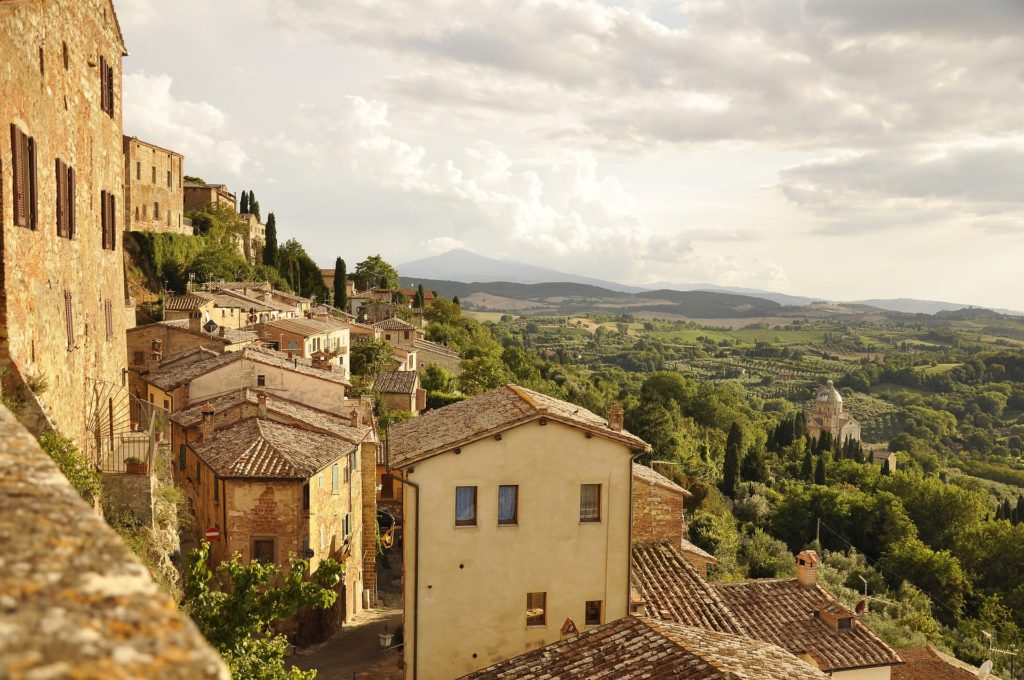
Perugia
Leaving Tuscany behind and entering in the region of Umbria, the green heart of Italy.
Perugia is the capital of Umbria, but it is also one of the Italian capitals of chocolate (yes, Perugina chocolate and Baci were born here)! Apart from that, Perugia is a beautiful medieval town set on a hill and still surrounded by ancient walls. It has an important university that makes the city quite lively considering its size. Do not miss the Fontana Maggiore, a marble fountain decorated with zodiac signs, a masterpiece of medieval sculpture. And then the Gothic cathedral and the Palazzo dei Priori with its art collection.
The most important event of the year in the city is the Eurochocolate fair, which attracts sweet teeth from all over Italy. It is held in the second half of November, and is a huge thing, which monopolizes the town for ten days. If you travel to Italy right in that period, I would probably advise you to avoid Perugia because the city becomes chaotic, prices skyrocket and it’s almost impossible to visit monuments and interesting places. But if you are a chocolate lover, that’s the right place for you!
I think that Perugia is one of the best places to visit between Florence and Rome. What about a food tour in Perugia (including wine and chocolate)?
Orvieto
Orvieto is one of my favorite villages, a medieval town perched on a rocky spur, with an Etruscan past that can be discovered underground. The Duomo of Orvieto is one of the most beautiful gothic churches in Italy: don’t miss the chance to visit the inside and see to the Corporale and San Brizio chapels. The Torre del Moro tower is the perfect place from which to enjoy the panoramic view. Don’t forget to visit the famous and suggestive St. Patrick’s Well! An amazing engineering structure built in the early 1500s at the behest of Pope Clement VII (aka Giulio de’ Medici): a well dug into the tuff for 54 meters deep, with two spiral ramps that descend without ever crossing, and which allowed mules to transport water to the surface.
- Check Altarocca Wine Resort in Orvieto for a great agriturismo with vineyards and wine tasting experiences.
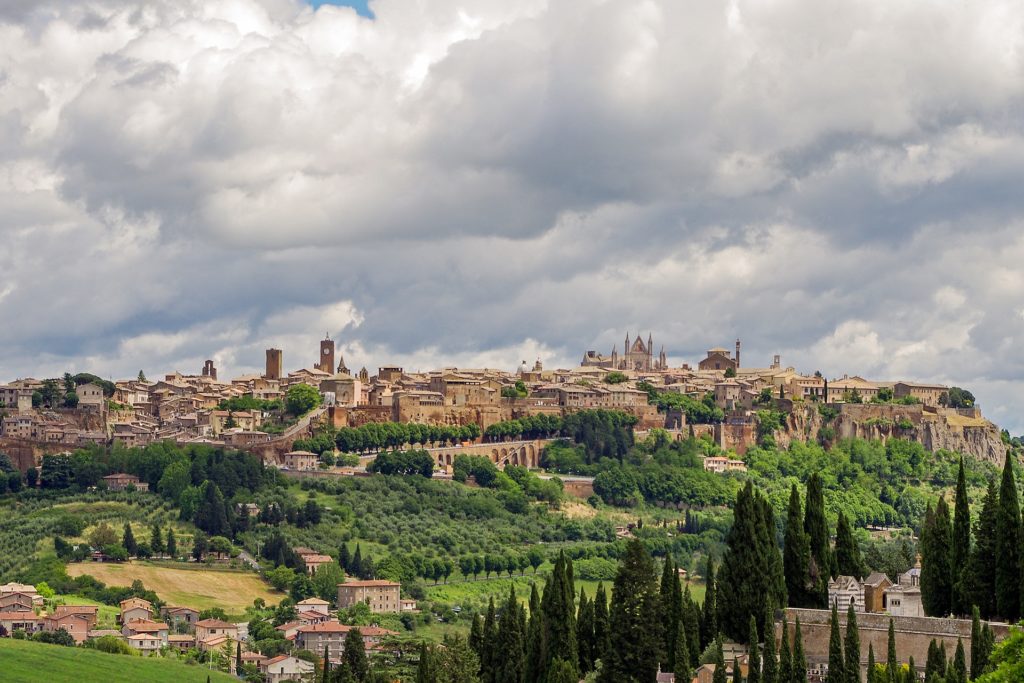
Viterbo
You’ll now leave Umbria to enter into the region of Lazio.
Viterbo was the seat of the papacy for over twenty years during the 1200s, and is still today is a medieval gem to see between Rome and Florence. The historic center is one of the most intact in Europe, with the ancient Palazzo dei Papi, the cathedral and the Rocca square.
For archeology lovers, I recommend visiting the National Etruscan Museum, where you’ll learn more about the Etruscan Civilization, which populated the regions of Tuscany and Lazio before the Romans.
- When I visited Orvieto I spent one night at Torre di Vico, a 12th century tower with gorgeous rooms.
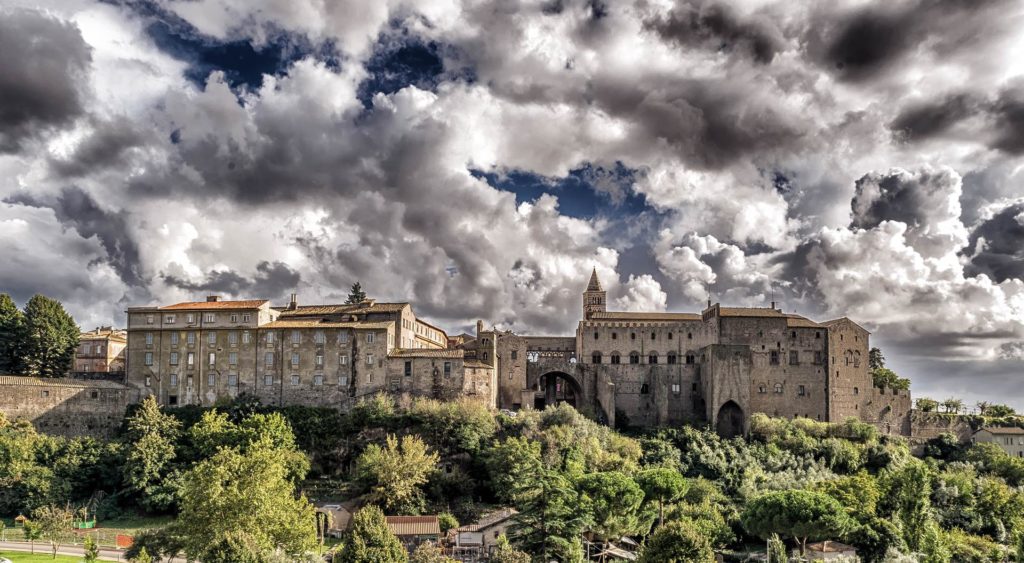
Civita di Bagnoregio ghost town
Civita di Bagnoregio is known as the dying city. It’s an ancient village build on the soft and friable local rock, tufo, that is literally crumbling due to erosion. Today there are only 11 people still living in Civita di Bagnoregio, and the only access to the town is through a bridge (as you can see in the picture below). Don’t miss the chance to see this Italian ghost town before it’s gone!
To visit Civita di Bagnoregio you must leave your car in the car park at the foot of the hill. The whole village is a pedestrian only area. There is a ticket entrance to the village (5 euro) that must be paid before crossing the bridge between 8 am and 8 pm. The access before and after that time is free.
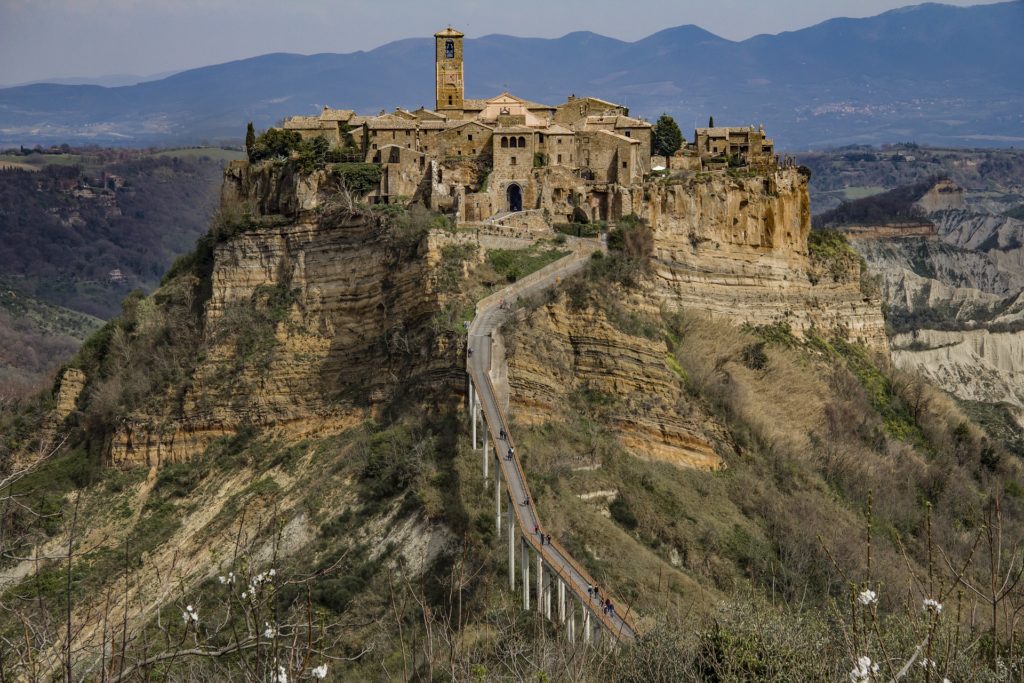
Since all the roads lead to Rome… Driving from Florence, we have now arrived in Rome and it is time to visit the capital! My best piece of advice is to drop your car in Rome and move around with public transportation. Even if the metro and buses are a nightmare, driving in Rome is an even worse nightmare.
Tips for a road trip from Florence to Rome
Here are some general recommendation to better organize your road trip in Italy. If you have any other useful tips to share, leave a comment below!
How long does it takes to drive from Florence to Rome?
Without making any stops it takes about 3 hours by car to go from Florence to Rome (and vice versa), using the A1 Autostrada (highway with toll). But in the event of traffic jams, road works or traffic accidents it may take longer, so be prepared for the unexpected. You can also decide to leave the highway and drive along the secondary roads: this is going to take way more time, but the drive will be way more scenic.
Is the drive pretty or scenic?
The highway itself offers some really pretty views of the landscape of Tuscany and Lazio. But each stop along the way means leaving the highway and taking secondary roads, and that’s where you will really enjoy the most scenic views of the Italian countryside.
Is it difficult to drive from Florence to Rome?
Driving on the highway is very easy: there are 3 lanes, speed limit is 130 km/h and you’ll find many service areas with gas stations, bars, restaurants and toilets (usually those service areas are called Autogrill). Driving on secondary roads in the countryside is as easy as well, there is usually not much traffic and speed limits are quite low (50-70 km/h).
Instead driving in big cities like Florence and Rome can be very challenging, because of narrow roads, traffic jams, traffic limited areas and lack of parking places. I don’t recommend that, unless you’re brave or really used to drive in Italian cities.
Rental car for a road trip from Florence to Rome
To find a rental car at the cheapest price, I recommend using Booking.com, it’s not just a portal to find accommodation, but is also comparing prices of the major car rental companies, which helps you find the right car for you at the best price. I am regularly using it also for my own trips.
How many stops along the way?
This mainly depends on how many days you want to dedicate to the road trip. If you want to get from Florence to Rome in one day, you will only have time to make one or two quick stops. But you can think of spending one or more nights along the way, and add other stops to the journey.
I hope this post was useful for you to organize your road trip in Italy, and decide what to see between Florence and Rome. Let me know which stops you will make by leaving me a comment!